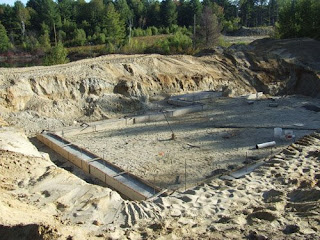Building Concrete Footings For A New House


In this part of the Country full depth basements are the standard when it comes to house foundations. Most houses are built on shallow foundations which are typically called spread footings. Concrete (spread) footings serve two main purposes. First they help “spread” out the load from the structure above. Secondly they create a level stable surface to begin building the foundation above on.
Depending on the type of soils that your new house will sit on the concrete footings will vary in width and depth. Every type of soil has an allowable load that it can take without settling and causing movement in your house. So the width of the footing is determined in order 

For this new house the footings will be 10 inches thick and 16 inches wide. That’s a very standard size spread footing around here with good soils. By the way, the soils here as you can see from the photos are very good. We have sand and gravel throughout this building lot site.

Here in New Hampshire we are required to place the bottom of the footing 4 feet below finished grade in order to protect the footing from frost. If the footings are too close to the surface then frost could potentially get under the footing and lift the house causing severe damage. This house has several footing elevations to accommodate different layouts within the house. For example, the main house has 8 foot high concrete walls. Those wall have almost 7 feet of cover below the finished grade. The garage will be built on 4 foot high frost walls so the footings will be 4 feet higher than the house walls. The basement of this house also has a walk out (walk outs are when the finished grade is at or below the slab grade). So those footings must be 4 feet below finished grade which means they will be 4 feet below the main house footings.
This probably all sounds a bit confusing but if you look at the photos you’ll notice what I’m talking about. Once the concrete walls are poured I’ll show you more photos and it will all start making sense.
The other issue to point out is the coordination with utilities. This house will have a mechanical room in the center of the basement. Therefore we’ll need to bring the electrical conduit and water line up from below the slab. In order to do that we placed sleeves in the concrete footings so we can slide the conduit and water line under the footings before we pour the slab.
So make sure you keep coming back to follow this series.
Previous posts from this series:
Total House Construction Series – Foundation to Finish
First Step In Building A New House – Blue Prints
Getting Bids When You Build A New House
New House Energy Efficient Details
House Building Lot
Ranch Style Home Floor Plan
Initial Site Work for House Building Lot
Recent Posts
Framing Stick Nailer vs Coil Nailer
Which is Better a Stick Nailer or Coil Nailer? Framers have many choices in nailers…
How Many Roofing Nails Per Square of Shingles
Estimating How Many Nails for a New Roof When it comes to estimating materials for…
Composite / PVC Decking – Layout Tips & Advice
Composite / PVC Decking Layout Tips and Advice Composite and PVC decking have really changed…
Benefits of an ERV System (Energy Recovery Ventilator)
Benefits of ERV Systems (Energy Recovery Ventilator) If you're building a new home or doing…
Vermiculite Attic Insulation Abatement
Vermiculite Attic Insulation If your home was built before 1990 there is a chance it…
Nuisance Tripping of AFCI (Arc Fault) Circuit Breakers
Arc Fault (AFCI) Circuit Breakers Tripping Often An arc-fault circuit interrupter (AFCI) or arc-fault detection…
View Comments
ı want to be a member for your website
dear mr.fratzel i am trying to build a home house for my family.my husband and had plan to build in stages as we work and save starting with foundation and plumbing.he was diagnois with dementia and given 6months but with the grace of god i had 11months with him after 42yrs of marriage our goal was to leave a home for our children or grands whom ever was in need of a start.since he has gone i am on my own again.my question for you is i live in arkansas and is confuse about the type of foundation that is best for my area. the land was use for farming and it do freeze in my area. what would you suggest.
Ann,
Sorry to hear about your husband. The foundation type really will depend on the local conditions and what is primarily used in your area. I would ask the local building code officials for some guidance as they can point you in the right direction. Typically if freezing is an issue you'll need a foundation that gets below the frost level.
Good luck.